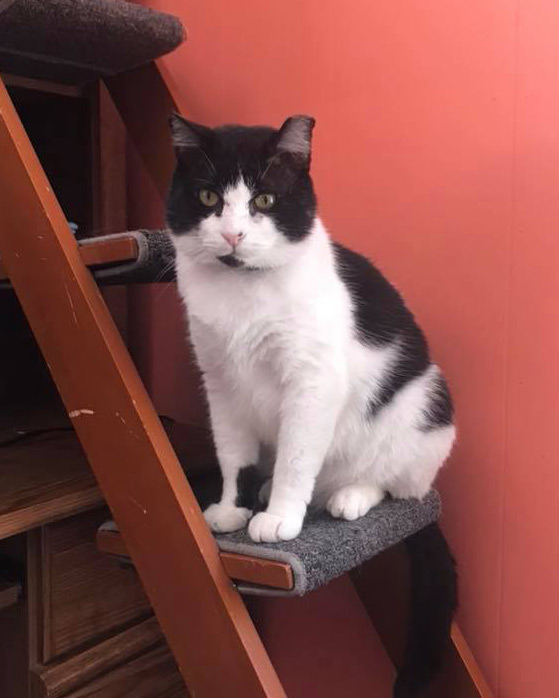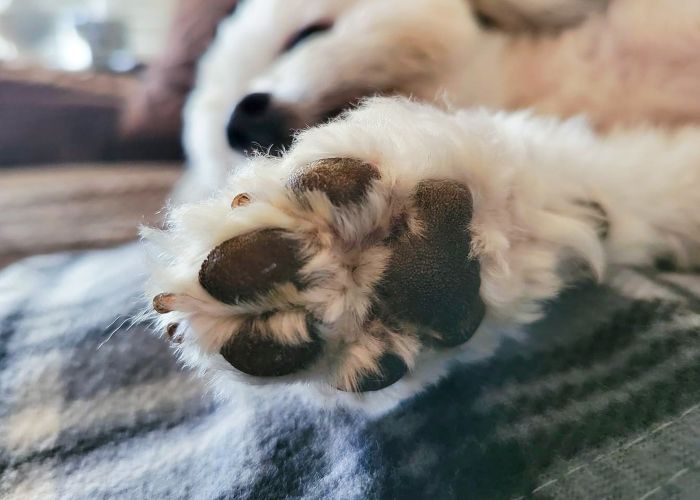How to: Adopt out “socially awkward” cats
Shelter and rescue staff share tips on supporting shy cats and new owners

Every morning when I arrived at my job at a small cat rescue in Maryland, I was promptly greeted by the excited screams of Archie—a scraggly black and white cat who expected me to give him a bowl of wet food before doing anything else. On mornings when I couldn’t function without a cup of coffee, he would continuously scream until I left the kitchen and walked over to him. I came to love our morning routine.
Archie had one of the boldest, and funniest, personalities I’d ever seen in a cat. But it took time to see those qualities since he was also very shy and nervous around most new people. When I first met him, he spent most of his time hiding in high-up spaces. If a stranger tried to interact with him, he would slink away, out of reach. After weeks of work, he became more comfortable with me, and we began to build routines together.

Every time a potential adopter came to look at cats, I would take them to Archie and gush over him like a proud parent. Adopters would politely nod their heads and attempt to pet Archie before asking to meet other cats.
It broke my heart to see people repeatedly overlook him. Then one day, a woman came in looking for a cat and listened to me as I rambled on about all of Archie’s quirks. She seemed genuinely interested and wasn’t deterred by his evasive behavior.
I explained that Archie had a lot to offer an adopter, but he would require patience. He wasn’t the kind of cat that you would have an immediate bond with; your relationship would slowly develop over time. To my surprise and delight, she decided to adopt him. I was so excited, I forgot to have her sign the paperwork (thankfully, she was very understanding and came in the next day to make the adoption official).
During my time at the rescue, I created what I jokingly called the “Shy Cats Club” for the group of cats I worked to socialize. Much of my time in this “club” was spent sitting on floors and ignoring the cats while I typed on my laptop.
After a while, the cats would slowly become more comfortable around me, and I would uncover new aspects of their personalities and interests, vital information I could relay to potential adopters. I also learned how to make the cats feel more comfortable: Archie loved having vertical space to explore; Peaches, a female orange cat with a strikingly loud purr, felt most comfortable in a room separate from the other cats; Tabitha, a small tabby cat, loved to be around kittens.
It saddened me that most people would not see this side to their personalities. Shy cats, like all cats, have diverse and interesting personalities. I found that some, like Peaches, were very affectionate but needed time to warm up—especially in a shelter environment. Other cats would always be more apprehensive and fearful.
I sometimes learned even more about the cats’ personalities after they were adopted and their owners provided us with updates. Archie, for example, formed a strong bond with his adopter’s boyfriend and would often cuddle in his lap (something we never saw him do at the rescue).

“While it can take time and patience to help a shy cat build trust and confidence in their new environment and with their new owners, watching them blossom is incredibly rewarding.”
—Amanda Kowalski, director of behavior programs, San Diego Humane Society
Home at last for shy cats
As much as I wanted each shy cat to be adopted, it was more important to me that they went to the right home for their specific needs. Shelter and rescue experts say it’s important to balance showcasing their positive attributes with managing adopters’ expectations.
Rachael Max, executive director and president of Here Today Adopted Tomorrow Animal Sanctuary, says it’s crucial not to set false expectations.
“We recognize [shy cats] for who they are, and we don’t try and turn them into something else,” she says. Shelter and rescue staff should explain what owning a shy cat will entail, such as being patient while their new companion adjusts to their home, and ask open-ended questions to gauge what potential adopters are looking for in a cat.
Although it’s important to be upfront about each cat’s needs, shelters and rescues also shouldn’t focus too much on the negative. There are many perks to adopting a shy cat, such as watching them build confidence firsthand, says Amanda Kowalski, director of behavior programs at San Diego Humane Society.
“While it can take time and patience to help a shy cat build trust and confidence in their new environment and with their new owners, watching them blossom is incredibly rewarding,” she says. “The first time they start to interact with you, like giving you a nose touch, or rubbing against you, is so gratifying and worth the wait.”
Alanna Regan, assistant manager and feline specialist at Dakin Humane Society, agrees. A shy cat “is going to make you work for it, and that relationship is going to be so much stronger,” she says. “She doesn’t just spread her love around to anyone, she keeps it just for you.”
Andrew Dorman, executive director of Cat Town—a rescue that focuses on finding homes for cats who may have a hard time getting adopted, such as elderly, frightened or injured cats—says a strong online presence can help tremendously in marketing shy cats. He recommends writing specific biographies for each cat instead of copying and pasting generic language. Organizations can also use social media to tell their stories: Posting multiple times about a shy cat’s development will help supporters feel invested in their journey, he says.

Regan encourages shelters and rescues to get creative in their marketing efforts. Dakin Humane Society uses the term “spirit cats” to describe shy cats and describes them as “slow daters” and “socially awkward.” Good photos are also key to a successful biography, adds Max, and organizations should avoid using photos where a cat looks scared, such as with folded back ears or hiding in the back of a cage. Consider asking fosters to record videos of shy cats in their element to include in the cats’ biographies.
Video meet-and-greats can also help adopters see shy cats in their best light. During the pandemic, Dorman’s organization transitioned to virtual meetups between potential adopters and cats due to social distancing protocols.
“I went to so many adoption meetings where the cat went and hid under the couch. We spent an hour with a potential adopter, and the cat hid under the couch the whole time because there’s a stranger in the home,” Dorman says. “By serendipity, we learned … that [video meet-and-greets] are a great, great tool for introducing shy cats to potential adopters because the cats are just behaving as they would with familiar people in the foster home and the potential adopter actually gets a better sense of the cat’s personality.”
Dorman says bringing a new cat into the home can be “emotionally challenging” for an adopter. Shelters and rescues can ease the stress of this transition by providing post-adoption support and educational resources; for example, the San Diego Humane Society even has a behavior helpline and virtual, five-week Shy Cat training class for pet owners.
Finding a home for a shy cat can also be emotionally challenging for shelter and rescue staff— something I learned myself while watching the shy cats I loved getting continually passed over. But when a shy cat finds that perfect home, it is that much more rewarding.







